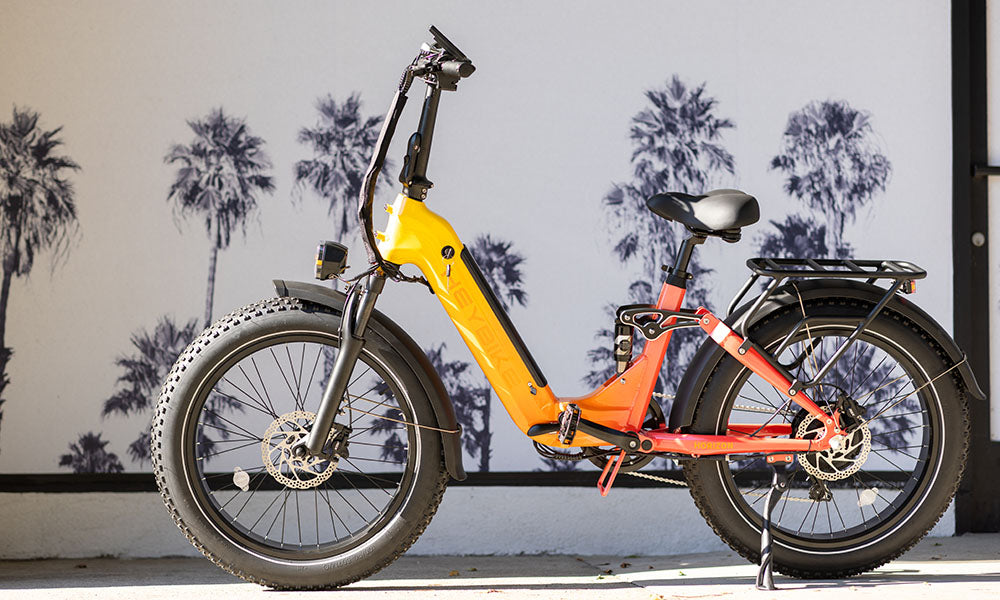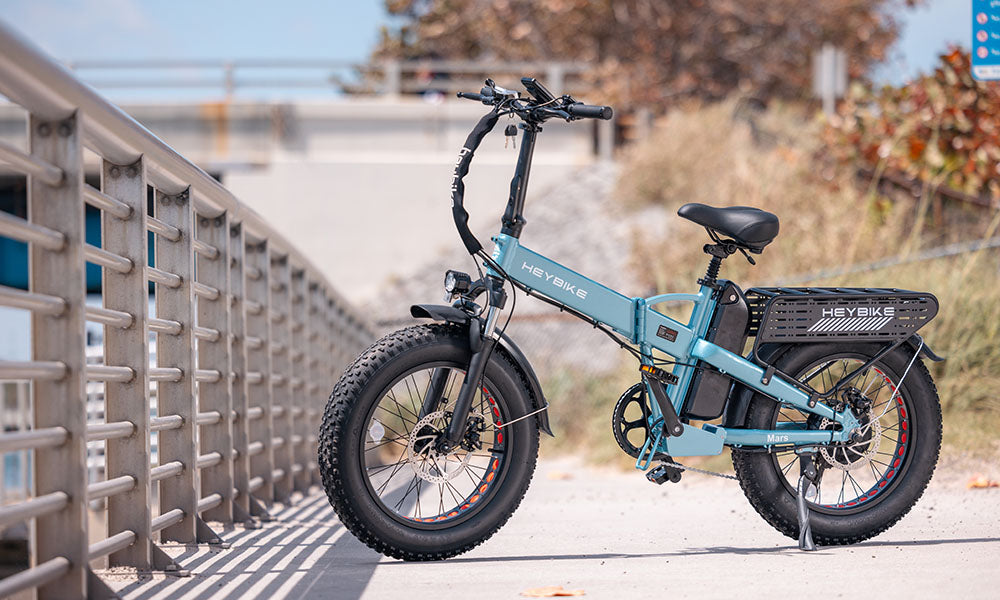
There are many factors to consider when choosing an electric bike. One of the most important is the power output, which is influenced by the electric motor’s wattage. The two most common wattage ranges are 750W vs 1000W Ebikes. Each type has their advantages and use cases.
In this article, you will learn about the differences between 750W and 1000W electric bikes. You will also learn what to consider when choosing between the two.
What is Motor Power?
Motor power is the power output of the electric motor measured in wattage. The average wattages on an electric motor are 500W, 750W, and 1000W.
Typically, the higher the wattage, the electric bike will accelerate faster and have a higher top speed. However, higher-powered motors are heavier and consume more energy than lower-powered ones.
Key Differences Between 750w and 1000W Ebikes
There are many differences between 750W and 1000W electric bikes. Understanding these differences is vital to choosing one that meets your needs. Let’s explore their unique traits in greater detail.
|
Quick Comparison |
||
|
Feature |
750W Ebike |
1000W Ebike |
|
Torque |
80 N·m |
100 N·m |
|
Top Speed |
Up to 28 mph |
Up to 32 mph |
|
Range (est.) |
Longer (more efficient at lower speeds) |
Shorter (uses more power) |
|
Ideal Use |
Urban commuting, moderate hills |
Off-road, heavy loads, steep inclines |
|
Weight |
Lighter, more portable |
Heavier, less portable |
|
Legal States |
Street legal in all 50 states |
Kansas, Georgia, Oklahoma, Minnesota, Oregon, and Virginia (safety measures needed) |
|
Best for |
Commuters, casual riders |
Adventurers, heavier riders, hilly terrain |
Speed and Acceleration
750W Ebikes:
Most 750W motors typically offer 80Nm of torque, which results in slower acceleration compared to higher-wattage motors. These Ebikes generally have a top speed of 28 mph, aligning with the legal limits for Class 3 Ebikes in many U.S. states. This makes them a practical and street-legal choice for everyday riders in most areas.
1000W Ebikes:
Equipped with approximately 100Nm of torque, 1000W motors provide quicker acceleration than 750W models. This makes them ideal for navigating rough terrain and ascending steep, off-road trails. These bikes commonly reach top speeds of 32 mph.
When deciding on a 1000W Ebike, it is crucial to comply with local Ebike laws, as state regulations can impose strict requirements on electric bikes, including maximum top speeds for urban commuting.
Range and Battery Life
Travel range determines how far you can ride before the battery depletes. When this happens, you can still ride the electric bike normally. However, you cannot use the electrical features, including the pedal assist and – if your Ebike has one – throttle.
While the travel range is influenced by the battery capacity, the power output of the motor is still a factor. Why? Because more powerful motors consume more energy. So, depending on how hard you apply the pedal assist or throttle, the result may be a reduced battery life and travel range.
Terrain-Conquering Capability
750W Ebikes:
For riders in areas with mostly flat surfaces or moderate inclines, a 750W electric bike should be sufficient for hill climbing. While the general rule is that more powerful motors offer greater hill-climbing ability, any Ebike with at least 55 N·m of torque will provide adequate assistance. Every electric bike from Heybike meets this torque requirement, allowing for excellent performance on most terrains.
1000W Ebikes:
If your riding often involves steep, rough surfaces and significant hill climbs, a 1000W electric bike is a more suitable choice. The increased power output and higher torque in a 1000W motor will provide more effective climbing capabilities for challenging terrains.

Weight and Portability
Weight and portability influence the ease that you can control your electric bike. When riding a heavy electric bike, you must anticipate corners sooner, as it takes more effort to turn the handlebars and tilt the frame from side to side.
Typically, 1000W electric bikes are heavier than 750W electric bikes. Why?
Because the motor is larger and bulkier, contributing to an overall heavier frame. Additionally, the frame itself is heavier, as it must be strong enough to handle the additional weight of the motor.
As a result, 1000W electric bikes are harder to carry than 750W ones, making them less portable. So, if your commute involves riding public transport (buses, trains) or navigating stairs, a 750W Ebike will be more portable.
What to Consider When Choosing Between 750W and 1000W Ebikes?
There are many factors to consider when choosing between 750W vs 1000W electric bikes. These include your riding style, local laws, and budget. Let’s explore these factors in greater detail.
Riding Style
How you ride influences the right type of motor for you. 750W electric bikes are best suited for urban commuting and light off-road trails. In particular, paths with moderate inclines. 1000W electric bikes, on the other hand, are best suited for fast performance and tackling steep inclines. In particular, climbing inclines on rough, uneven surfaces.
Think about where you plan to ride, and how challenging your journeys will be. Evaluate your physical capabilities. If you are not confident in handling a heavier bike, stick with a 750W model.
Local Laws
Virtually all states in America have local Ebike laws. These laws enforce license, insurance, and taxation requirements. They enforce maximum top speeds. Most states recognize three universal Ebike classes.
These Ebike classes are as follows:
- Class 1: only pedal assist (up to 20 mph)
Class 2: pedal assist and pure throttle (up to 20 mph)
Class 3: only pedal assist (up to 28 mph)
Refer to your electric bike state laws as they apply to your area. Even still, most electric bikes let you adjust the top speed for each pedal assist (PAS) level. This way, you can comply with local laws, regardless of Ebike model.
Budget
Choose an electric bike that matches your budget. Typically, 1000W electric bikes are more expensive than 750W electric bikes. Why? Because they have more powerful motors, higher-capacity batteries, and sturdier frames.
There are exceptions to this rule, though. It is possible for a 750W Ebike to be more expensive than a 1000W Ebike. This can happen if the 750W model has higher-quality components – hydraulic disc brakes, torque sensor – and a unique frame.
Don’t just choose the most expensive Ebike. Find one that suits your price point and has the features you need. Below are some recommended ebikes to help you decide.
Recommended 750 Watt Ebike
The Heybike Horizon is a 750 watt electric bike with a full suspension system. The 750W hub motor has a peak output of 1400W and 80Nm of torque, enabling you to climb moderate-to-steep inclines easily. Additionally, the Horizon has 24x4” fat tires, making it ideal for off-roading.

Recommended 1000 Watt Ebikes
Ranger S
The Ranger S is a powerful 1000W electric bike with a compact folding frame. With a peak power output of 1800W and 100Nm of torque, it can reach a top speed of 32 mph and travel 55 miles on a single charge. Plus, the folding design makes it easy to store in compact spaces, including apartments and car trunks.
These qualities make the Ranger S perfect for urban commuting and light off-roading. Whether you are riding to school, work, or the store, the Ranger S will take you far on a single charge. And quickly, too.

Mars 2.0
Like the Ranger S, the Mars 2.0 is a powerful electric bike with a compact folding frame. It has a 1000W brushless hub motor, hydraulic disc brakes, 20x4” fat tires, and a high-step frame. The electric motor can reach a top speed of 32 mph, enabling you to climb steep hills quickly and easily.
Another great thing about the Mars 2.0 is the compact folding frame. Fold the frame in half and store it in tight spaces. For example, in the corner of your apartment or the back of your vehicle.
The rear rack can hold up to 120 lbs of cargo, and accessories like bike locks and water bottles can be attached to the pegboard.

Wrapping Up
The electric motor is one of the most important components of an electric bike. This can make choosing the right motor type hard. Do you prioritize acceleration and speed over a lightweight frame? Or do you favor agility over a lower top speed?
Use your best judgment. Choose an electric bike that meets your needs and personal preferences. Also, contact the manufacturer directly for advice. Visit the Heybike Support Center for answers to common questions and more.


Share:
20-Inch Electric Bikes: Everything You Need to Know
Meet the New Ebike Lineup at 2025 CABDA EXPO with Heybike
2 comments
I specifically was looking for comments of the Ranger S 750W vs Ranger S 1000W. Your info here only shows the the Ranger S comes with the 1000W. I Need the comparison between the 750W vs 1000W. I am buying two of them!
How far distance